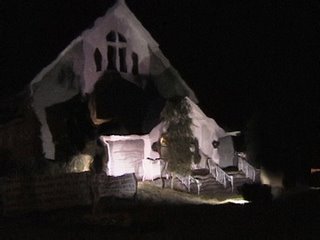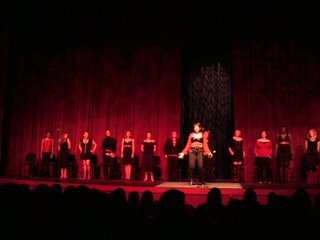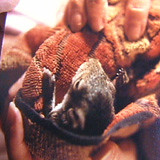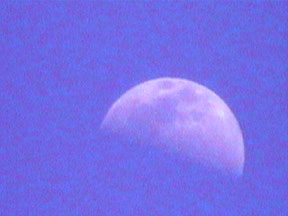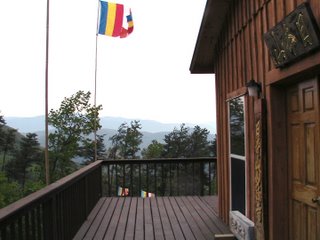
To the Great Smoky Mountains Peace Pagoda, near Newport Tennessee, to take part in one of their annual Flower Festivals.
The ride is an easy interstate run across the land of Anywhere. 1:40 minutes, most of which is driven through a trance, of sorts.
We exit the Interstate at the small town of Newport at a gasoline station/restaurant that looks as if it crashed while trying to land on the highway.
The next part of the trip is steep. As scripture warns, it is a narrow way indeed, but sadly none of it is straight. Our directions keep us safe though, and lead us through a baffling array of parked All Terrain Vehicles, huge garages, trampolines, semitrailers and doublewides. The further we go, the steeper becomes the road. Finally we enter a dark, wet, cold and dismal world of thick clouds. Our world becomes tiny, gray and gravelly.
We exit the cloud cover into a band of winds - are these are the fabled winds that protect the approaches to heaven? All of a sudden we don’t know - not sure of anything. The world seems changed somehow, no longer a place we have ever been.
Suddenly the Temple rises boldly out of the clouds, riding into the wind like a great ship. Slender flag poles, some planted along the road, and others tied to the deck are bent by that wind, their flags slapping and popping. We park and walk through a door surrounded by discarded shoes into the temple.

Laughter, gold and glitter, gaiety, friendship, hugs and sometimes even kisses, the people here all know each other well, even if we have never really met before. We all have come from far away. most have been here before but that was always long ago. The room is large. A very thick rug lies over its hand-hewn, polished floor. Prayer rugs lie over the carpet and also are scattered along the floor. Seating (or kneeling) mats are available all over the floor, a few chairs are also available for those who require that. The Temple is filled with the smell and sight of floating incense.
A chime rings out high and clear, and people settle upon mats and into chairs. More incense is lighted accompanied by a series of chimes. Then a gong sounds, its vibrations uniting the temple, the furnishings and the people into a harmonic unity.
Br. Utsumi kneels before a prayer lectern, and begins the celebration in Japanese. The congregation has a bulletin printed in “Anglo-Japanese” so we can take these holy words Utsumi says and try to make holy word-sounds, if we wish to try. We do a pretty good job.
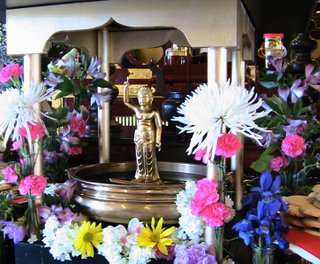
The ceremony concludes as those of us who wish approach the altar. We bow on prayer cushions before a small golden Buddha which stands in a small flat bowl filled with sweet tea. A wooden ladle is provided to pour the tea over the Buddha three times. Meanwhile, Utsumi is chanting words which roughly translate to: “Now I am sprinkling this sweet tea on the Eternal Buddha. Praise to the Eternal Buddha, the Deserver of Offerings, the Perfectly Enlightened One, the One of Wisdom and Practice, the Knower of the World, the Teacher of Gods and Humans, the Buddha, the World-Honored One.” Chimes ring out, two deep gongs sound, the sunlight flashes from endless golden objects and we are all washed in incense.
Miso soup, hummus, marinated green and red pepper slices, flat bread, beans and tofu, crackers and salad follow. All of this is consumed with laughter and happy talk. Plans are made, anticipations and revelations revealed. Later we all tour the substantial complex that comprises and supports the Temple. Finally we walk up to to the top of the mountain - the site of the Pagoda-to-be. The land is cleared now. Cement blocks, stacked two high are scattered 10 - 15 feet apart, forming a circle some 80’ in diameter. They support weathered wooden planks that reach from one stand of blocks to another and provide a glimpse of the size of the Pagoda.
Then it is time to go. Good-byes, farewell hugs, and two hours later we are walking our doggies in our own woods at own home.
© John Womack, 2006. All Rights Reserved.
